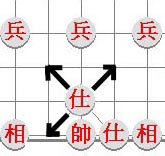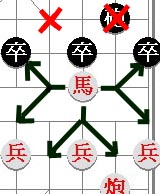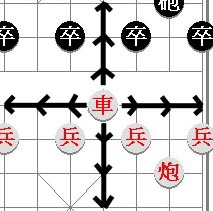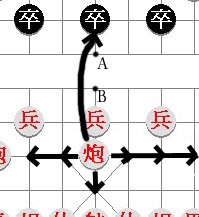The chinese chess or xiangqi (象棋) is one of the most popular and widely played board games in China for many centuries. Like the international chess it is played by two players, each controlling an army of two different colours usually green (or black) and red.
The pieces on each side:
- King (1)
- Guard (2)
- Bishop (2)
- Knight (2)
- Rook (2)
- Cannon (2)
- Pawn (5)

Pawn 
Cannon 
Rook 
Knight 
Bishop 
Guard 
King
Note the characters look different for some pieces. They are the same pieces with the same power. You might find some other slight variations or colours and they are the same game.
Rules:
- The chinese chess is played on the points of intersecting lines, rather than on the squares on the board.
- The king moves one space at a time (left, right, forward or backward). He is confined to the fortress on his side of the board.

- The guards are also confined to the fortress. They move one space at a time diagonally.

- The bishops move two spaces in any diagonal direction. This piece can be blocked by another piece on the intervening square (A and B in diagram), and is not allowed to cross the river to the other side of the board.

- The knights move first one space along the horizontal/vertical line and then one space diagonally similar to the international chess. But this knight can be blocked by an intervening piece. The knight in the diagram cannot move to the spaces marked by red X, it is blocked by the black pawn.

- The rooks move exactly like the international chess as many spaces horizontally or vertically as they wish until they meet another piece or the edge of the board.

- The cannons move like a rook when not capturing. To capture a piece it must have a piece (friend or foe) in line to jump over. In this diagram, the cannon can capture the enemy’s pawn. It cannot move beyond that pawn, or to the unoccupied spaces A or B.

- The pawns move one space forward. But after crossing the river, it may move one space to the left or right or forward but never backward. It captures just as it moves normally. It does not get promoted to any rank upon reaching the far end of the board.

- The object of this game is to force capture of the enemy’s king. This may be checkmate or by stalemate (he is not under any immediate threat but there is no legal or safe move).
- It is not allowed to give perpetual check or attack. If the game is repeating its position, the player forcing the repetition must do something else.
- There is one special rule about the kings. The two may never face each other on the same line across the board, with no intervening pieces between them.
- Usually red makes the first move to begin the game.
- When a game is not winnable, it is strongly recommended both players draw the game by themselves.
- There are some advanced rules in tournament but you do not need to worry about it.
